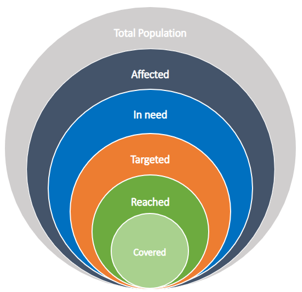...
Breaking Down the Humanitarian Profile
...
The Population Statistic COD (COD-PS) Total Population is the basis for finding the Humanitarian Profile COD (People Affected). The Humanitarian Profile COD is disaggregated to provide a better understanding of the affected population. Later on in the response, data will be disaggregated and more data will be added to understand the population's vulnerable groups and needs to calculate the number of People in Need (PIN).
...
The Humanitarian Profile COD Terminology
The Humanitarian Population Figures represent the relationship between sets of the total population of a given territory in an emergency response.
...
Total Population (COD-PS) Includes all people living within the administrative boundaries of a nation state. Note: there can be a crisis-specific strategic decision to calculate the total population looking only at a sub-national level. Example: 8 million people live in the country of Alpha which was recently hit by a crisis. This includes 500,000 refugees who came to the country one year ago. The total population is 8 million people.
People Affected (COD-HP) Includes all those whose lives have been impacted as a direct result of the crisis. This figure is often the first available after a sudden onset emergency and often defines the scope or boundary of a needs assessment. It does not, however, necessarily equate the number of people in need of humanitarian aid; it should not be consumed or interchangeable with the category People in Need. Characteristics of the category People Affected must include: Being in close geographical proximity to a crisis. Physically or emotionally impacted. Experiencing personal loss or loss of capital and assets as a direct result of the crisis. Being faced with an immediate threat from a crisis.
When a crisis becomes protracted and its effects deepen and spread, the definition of Population Affected may need modification to include populations that may be more geographically distant from the center of the initial shock and not have been physically/emotionally impacted but experiencing secondary effects of a disaster/crisis.
Example: The Country of Tallias has a Total Population of eight million people. Six million people living in three provinces were exposed to damages and destruction following an earthquake. The population suffered injuries, damaged to dwellings and lives in areas that are at high risk of aftershocks—they are population affected. Example: Two million out of the country of Genovia’s eight million population were not affected. Thus, the population affected equals 6 million people. |
...
People in Need (PiN) People in Need are a subset of the Population Affected and are defined as those members: Whose physical security, basic rights, dignity, living conditions or livelihoods are threatened or have been disrupted, AND Whose current level of access to basic services, goods, and social protection is inadequate to re-establish normal living conditions with their accustomed means in a timely manner without additional assistance This category is further broken down into sub-categories or by sector/cluster to provide additional detail about the intensity, severity or type of need.
Example: In the most populous provinces, where 5 million people out of the 6 million People Affected reside, 90% of the buildings and infrastructure were destroyed in the earthquake, and roads rendered inaccessible. Those people are in need of assistance. Out of the 5 million, the number of those who have sustained critical injuries, are inaccessible or living in dwellings at risk of collapsing is estimated at 2 million. They are in need of immediate assistance. People Targeted People Targeted is a sub-set of People In Need and represents the number of people humanitarian actors aim or plan to assist. This projected number is typically smaller than the number of People in Need, given: a) it is rare that international humanitarian actors can meet all needs; b) needs are also being addressed by actors not participating in the joint plan, including national Governments; and c) people in need are not always accessible.
Example: 2 million out of the 5 million people in need will be targeted for the delivery of tents and shelter material as well as health assistance. People Covered Example: 1.5 million people have received family tents and shelter material as well as access to medical services. 1 million people have access to materials to repair their housing fully within the next three seeks and their shelter needs are thus covered.  Image Removed Image Removed |
Resources
...